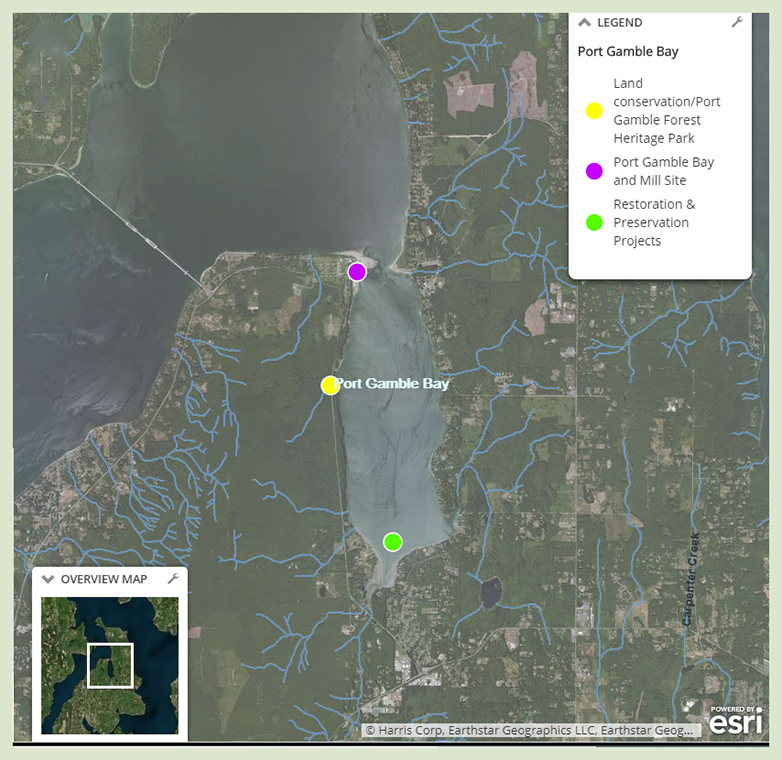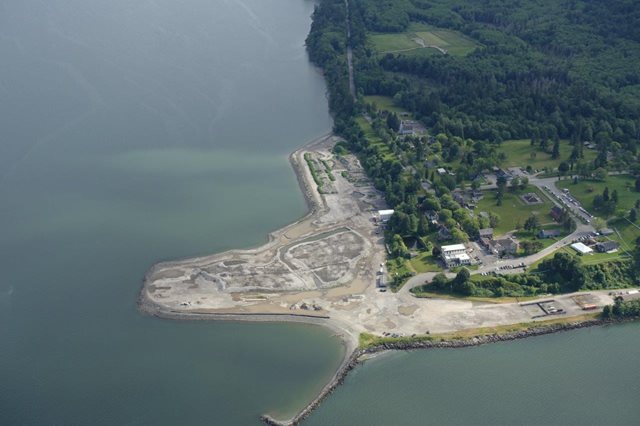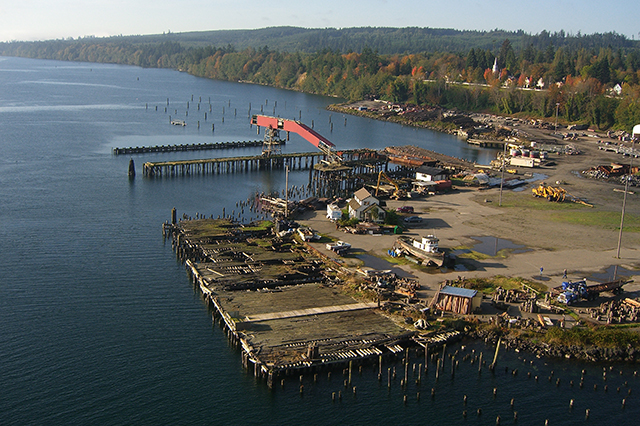Port Gamble Bay and Mill Site
Port Gamble Bay and Mill Site was selected as a Puget Sound Initiative cleanup site due, in part, to its high-quality natural resources, such as shellfish, crab, and other fishery resources. Cleanup combined with large-scale habitat preservation and restoration activities in the watershed has made giant leaps toward improving the bay for recreation, subsistence harvest, and supporting a healthy place to work, live, and play for Tribal and community members, and visitors alike.
The Port Gamble baywide cleanup is one of the largest creosote-treated piling removal projects in Puget Sound. It has removed over 8,500 creosote-treated pilings and tons of contaminated wood waste from historic mill operations. Creosote leaches from treated pilings and structures, and is found in surrounding sediment and water. Shellfish, such as mussels and clams that are consumed by humans and fish, can accumulate this leached contamination. Wood waste from log rafting, chipping, and other mill activities built up on the sediment surface. Breakdown of wood waste can release chemicals into the environment and makes an inhospitable environment for bottom-dwelling creatures, which are important prey for salmon, other fish, and shorebirds. Removal of pilings, wood waste, and contaminated sediment improve conditions for humans and the aquatic environment.
Background
Port Gamble Bay is located in northern Kitsap County. The Port Gamble Bay and Mill Site includes the area on which a former sawmill was located, adjacent uplands, and most of Port Gamble Bay. The site was used by Pope and Talbot, Inc., to manufacture forest products for 142 years, from 1853 to 1995. The mill was shut down in 1995 and removed in 1997, after which the area was leased for log sorting, wood chipping, marine research, and other light industrial activities. Pope Resources, LLC and Olympic Property Group, LLC (Pope Resources/OPG, LLC) currently own and oversee the cleanup site.
Historical operations on the property resulted in the release of pollutants from wood waste and pilings. These included creosote, cadmium, mercury, petroleum hydrocarbons, carcinogenic polycyclic aromatic hydrocarbons (cPAHs), and dioxins/furans. Some of these contaminants were found in soil surrounding the mill, and in sediments and shellfish tissue in Port Gamble Bay. Mill activities also deposited wood waste on marine sediments and affected bottom-dwelling organisms. When large amounts of wood waste break down in the environment, it releases sulfide and ammonia, which are harmful to these benthic organisms. Wood waste can also smother aquatic habitat and animals, such as clams.
Cleanup goals and objectives
To guide cleanup of the in-water portion of the site, the following goals and objectives were developed:
- Address threats to human health and the environment
- Maximize active cleanup.
- Achieve the quickest time to full recovery
- Minimize impacts of cleanup on the environment and to the surrounding community
- Integrate cleanup actions with habitat improvements and restoration actions
Given the high-quality resources present in the bay, cleanup goals also included improving fish and shellfish habitat within the cleanup footprints.
Cleanup status
In-water cleanup
After more than 10 years of planning and design, the in-water portion of the Port Gamble Bay and Mill Site is cleaned up. Cleanup began in September 2015 and was completed in January 2017. The two-year construction effort removed creosote-treated pilings, derelict overwater structures, wood waste and contaminated sediment harmful to marine life. Large areas were also capped with clean sand to accelerate natural recovery of the sediment.
Mill site and upland cleanup
Ecology conducted a study in 2014 and identified areas of contamination that remain on the mill site and in upland areas. We are working with Pope Resources/OPG, LLC, to address remaining contamination on the mill site and uplands once the sediment stockpiles from in-water cleanup are removed. This work will include development of a new Agreed Order, Work Plan, supplemental Remedial Investigation/Feasibility Study and Cleanup Action Plan. These documents will be available for public comment in fall of 2017 and in 2018.
In-water cleanup highlights
- Creosote-treated pilings removed: 8,592
- Wood waste and contaminated sediment removed: 110,537 cubic yards
- Overwater and derelict structures removed: 56,500 square feet
- Clean capping, habitat and other materials placed: 224,091 tons
- Clean sand placed to accelerate natural recovery: 113,342 cubic yards
- Length of shoreline improved along mill site: 3,485 linear feet
- Total area cleaned up: over 106 acres
Sediment and wood waste from the cleanup was temporarily stockpiled on the mill site and has been moved to a permanent disposal facility (a limited purpose landfill located at the model airplane field). The mill site and limited purpose landfill are currently being managed by Pope Resources/OPG, LLC. Long-term monitoring of the in-water cleanup will begin in 2018 to ensure that it remains effective.
Combined with extensive habitat preservation within the watershed and restoration efforts throughout the bay, the cleanup is a major achievement for people and the environment.
Why does this work matter?
Combining cleanup, restoration, and preservation efforts improves habitat for fish and shellfish, generates economic opportunities, and paves the way for future work. Cleanup and restoration:
- Created a healthier and safer environment for fish and shellfish, and for people who live and work on the bay by removing contaminated sediment, sources of contamination, derelict structures and vessels, and beach debris (e.g., bricks, nets, trash, and tires).
- Improved aesthetics by removing derelict structures, pilings, trash, and debris from beaches.
- Enhanced recreation in the bay (e.g., boating, fishing, shellfish harvesting, hiking, biking, bird watching).
- Provided jobs to bay residents and the broader community.
- Supports future restoration and conservation efforts in Port Gamble Bay and Hood Canal.
What’s next?
We and Pope Resources/OPG, LLC will continue joint efforts in 2017 and 2018 to address remaining contamination on the mill site and uplands.
Cleanup costs
Ecology and Pope Resources/OPG, LLC contributed to cleanup of the bay. In 2007, we contributed approximately $1 million to dredge wood waste around the mill site. From 2013 to 2015, we contributed over $1.4 million toward cleanup planning and oversight. Pope Resources/OPG, LLC, paid over $20 million to complete the in-water cleanup work.
Related links
Contact information
Corey King
Baywide Project Manager
Corey.King@ecy.wa.gov
360-280-5684




